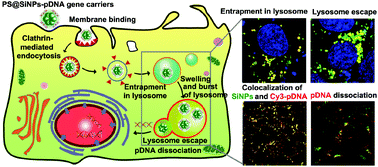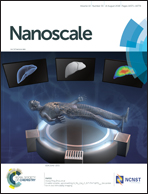Biocompatible protamine sulfate@silicon nanoparticle-based gene nanocarriers featuring strong and stable fluorescence†
Abstract
The development of biocompatible and fluorescent gene carriers is of particular importance in the gene-delivery field. Taking advantage of the unique optical properties (e.g., strong and robust fluorescence) of silicon nanoparticles (SiNPs), as well as the excellent biocompatibility of silicon and protamine sulfate (PS, approved by the U.S. Food and Drug Administration (FDA) for clinical use), we herein present a type of PS-modified SiNP (PS@SiNP)-based gene carrier. Plasmid DNA (pDNA) with negative charges can be effectively bound onto the surface of the as-prepared fluorescent PS@SiNP-based gene carriers via electrostatic interactions. In particular, such resultant gene carriers possess stable and high fluorescence (photoluminescent quantum yield (PLQY): ∼25%). In addition, the PS@SiNP-based gene carriers show minimal toxic effects on normal mitochondrial metabolic activity (e.g., human retinal pigment epithelial (ARPE-19) cells preserve ∼90% of their cell viability after a 48 h incubation with the resultant carriers). Based on tracking the strong and stable fluorescence signals of SiNPs, the dynamic behavior of the PS@SiNP-based gene carriers in live cells (e.g., clathrin-mediated endocytosis, lysosomal escape, pDNA release, etc.) is investigated in a long-term manner, providing valuable information for understanding the intracellular behavior of gene vectors and designing high-efficacy gene carriers.



 Please wait while we load your content...
Please wait while we load your content...